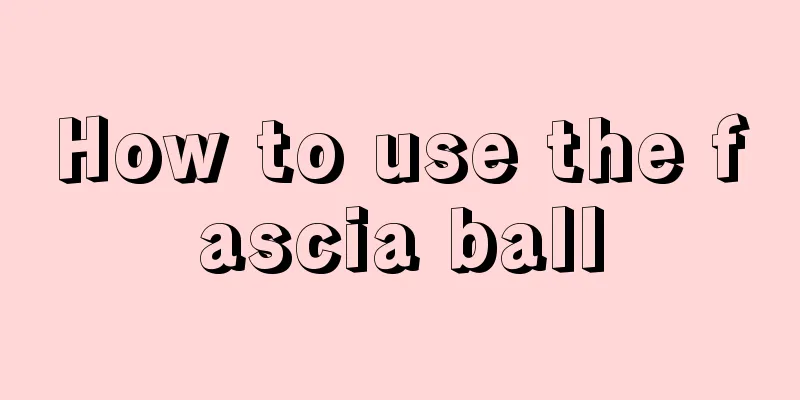How to use the fascia ball

|
When it comes to fascia ball, everyone is familiar with it. A fascia ball is a massage ball about the size of a tennis ball. It can massage the soles of the feet and stimulate the acupuncture points on the soles of the feet, which can achieve a health-care effect. In their spare time, people can place the fascia ball under their feet for both relaxation and massage. Fascia balls can effectively exercise muscles, so what else can you massage besides massaging the soles of your feet? Do you feel muscle soreness, tension, fatigue? You do regular stretching exercises, but with no effect? You reduced the training weight, tried rehabilitation training, and even took a hot bath. You know you need deep, effective soft tissue treatment. It would be great to get a massage right now.The problem is that not everyone has the time or money to undergo soft tissue therapy. Want to find a simple, cheap and effective way to eliminate pain? Most people think of using a foam roller to relax after exercise, using the pressure of their own body weight to relax tense muscles, thereby relaxing fascia and muscles, and completing post-exercise recovery. However, smaller muscle groups or parts cannot be worked using a foam roller, so a fascia ball comes in handy. A small fascia ball can help you solve this problem. As long as you master the correct usage, it will become your good friend. The massage will be painful, but not unbearable. If you feel severe pain, stop immediately. Maybe you're already hurt. Massage movements should be slow. Slowly roll the fascia ball up and down the muscle, stopping at the most sensitive points. Those may be trigger points. Roll the ball up and down the muscle 5 times, or roll it around an area for 30 seconds and hold it on a trigger point for 30 seconds. The exact number of repetitions for each muscle is not important; you will know the answer once you try it. When you hit a trigger point, you'll feel pain deep within the muscle. It doesn’t matter, just grit your teeth and hold on. If that spot is indeed a trigger point, the pain will be most intense when the ball first hits it. After persisting for a period of time, the pain will ease. As you massage an area, roll the ball around to identify trigger points. Trigger points usually exist in certain specific areas, but you don't have to look for them specifically in those areas. You just need to roll the ball around and find the trigger points yourself. 1. Plantar fascia relaxation There are no trigger points on the feet, but fascia ball massage can relax the feet. The function of the plantar fascia in your foot directly affects the rest of your leg. Most of us have tight foot muscles. Training methods: Stand on one leg with your free leg on the ball and your weight on the supporting leg. Roll the ball around the soles of your feet. Roll the ball a little longer on any sore spots. Do this for 40 seconds, 3 sets on each foot. 2. Piriformis muscle You've probably heard of this little, often painful, annoying muscle called the piriformis. It is one of the hip rotators that requires attention and causes the most problems. Training methods: Sit on the ball with your buttocks and roll in all directions, you will find your piriformis. This muscle is small, and when you touch it, you'll feel pain running down your leg. Hold this point for 30-60 seconds, and you will feel relaxed after the massage. If the pain is severe, straighten your legs, that is, without hyperstretching the hip rotators, and hold this position for a while. The massage effect will be less effective when your legs are straight, but at least it will give you a good start.
This part of the fascia on the side of the thigh is almost always tight and often has trigger points. In this area, the main function of the fascia ball is to simply restore the fascia; but there are also some trigger points closer to the hip joint. Training methods: Roll the fascia ball upward from the knees toward the hips. If you reach a point where you feel sore, stop and hold for a while. The ITB is often very tight and massaging this area with a myofascial ball may be painful. I personally feel that the fascia ball can provide better core stretching than the foam roller, but it is not easy to find the trigger points. 4. Back of the calf Almost everyone has trigger points in their gastrocnemius and soleus muscles, but most are not aware of their existence. Training methods: Sit on the ground and then raise your body a little higher. The further your body is from the ground, the more pressure you exert on the ball. Place the ball under the back of your calf. Roll the ball slowly from your Achilles tendon down underneath your knee. When you encounter a sensitive point, stop and hold for a while. Since the back of your calf is so wide, you'll need to try multiple rolling paths to hit the inside, middle, and outside. 5. Erector Spinae Our sitting posture is often not standard, which leads to tension in the erector spinae muscles (the erector spinae muscles are long muscles distributed on both sides of the spine, extending from the lower back upward to the neck). This method may not find many trigger points on the erector spinae muscles, but because the thoracic and cervical vertebrae need to improve flexibility, they are often very tense, and fascia ball massage can help achieve these goals [ps: It is recommended to use a peanut ball here. When using a peanut ball to massage the erector spinae muscles, the space between the two balls can just avoid the spine, so it will not put a lot of pressure on the spine. Training methods: Place the peanut ball on the ground behind you. Slowly lie down on your back, stretching your body over the two balls. Initially, place the ball as shown in the diagram. You will find that these two balls can just massage the erector spinae muscles, and the space between the balls can prevent compression of the spine. After massaging one area using stretching movements, sit up, move the ball slightly forward, and lie back down again to massage another vertebra. Gradually move up the back. As mentioned above, this method is not very effective for treating trigger points. But since many people have poor posture, this method can help straighten the spine and relieve back spasms. This approach can also be helpful in treating a herniated disc, which can cause tension in other areas of the back. 6. Posterior shoulder capsule Training methods: With your back to a wall or lying down, hold the ball between your body and the wall, with the ball located behind your shoulder. To enhance the effect, bend the arm on the exercise side horizontally in front of your chest and secure it with the opposite hand. Slowly roll the ball back and forth in a small range behind your shoulder. Maintain the movement for 30-60 seconds, then switch to the opposite side to practice.
The infraspinatus and teres minor, which are located behind the scapula, are both external rotators of the scapula. The other two muscles are located very deep and only professionals can accurately find their locations. Rotator cuff tightness and trigger points are common causes of shoulder pain. Sitting in the wrong position, keeping your arms overhead for long periods of time, using a mouse with one hand, typing for long periods of time, and not giving your elbows time to rest can all cause tension in these muscles. The following methods can relieve the problem of compressed nerves in the shoulder. Training methods: Lie on your back on a fitness mat with the ball between the shoulder strap and the mat. Abduct the shoulder of the arm on the ball side and bend the elbow 90 degrees, so that the upper arm is flat on the mat. Slowly rotate the shoulder joint on the ball side internally and externally. Repeat 8-10 times, then switch to the other side. First, you need to locate the infraspinatus and teres minor muscles. They are located behind the shoulder blades, which is the place on the back that is pressed red by the fascia ball in the picture. |
<<: Symptoms of blocked arm meridians
>>: Can I use a facial mask during menstruation?
Recommend
How to treat androgen-resistant prostate cancer
A very good friend of mine has prostate cancer. R...
What is the best treatment for fibroids
What is the best treatment for fibroids? Patients...
What should I do if the toes of my shoes rub my feet?
Many girls love beauty and often wear high heels....
My face is red and hot, sometimes my ears feel hot and my eyes have red bloodshot
For people with sensitive facial skin, redness of...
What are the dangers of washing your hair frequently in the morning?
Washing hair is a very common phenomenon. Some pe...
Men should always take precautions against prostate cancer
Prostate cancer is a relatively serious type of c...
How can we effectively prevent liver cancer? To prevent liver cancer, we must do three things and don't do three things
Liver cancer has the characteristics of rapid ons...
Pain care for elderly patients with bone cancer
How to provide pain care for elderly patients wit...
Things to note after treatment of mole under the clavicle
If there is a mole in a conspicuous part of the b...
Learn about the nursing methods for lung cancer in advance
In recent years, the number of patients with lung...
What is dental calculus_How is dental calculus formed
Dental calculus is actually a type of dental plaq...
What are the common methods for treating liver cancer? What are the most effective liver cancer treatment methods?
What are the common treatments for liver cancer? ...
What are the symptoms of advanced liver cancer one month before death? Symptoms of advanced liver cancer before death
Liver cancer is one of the cancers that threaten ...
What does it mean to have a mole on the middle finger of the left hand?
People can have all kinds of skin problems, inclu...
How long can you live with mid-stage lymphoma? What are the precautions?
Lymphoma patients generally do not live long in t...









